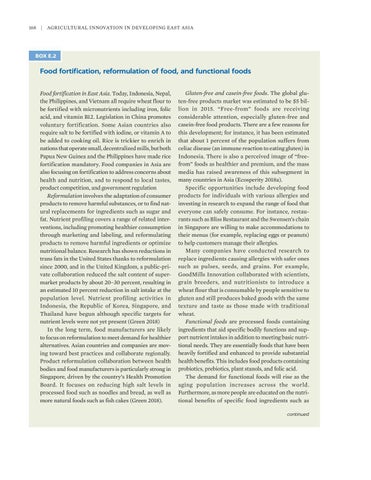168 | Agricultural Innovation in Developing East Asia
BOX E.2
Food fortification, reformulation of food, and functional foods Food fortification in East Asia. Today, Indonesia, Nepal, the Philippines, and Vietnam all require wheat flour to be fortified with micronutrients including iron, folic acid, and vitamin B12. Legislation in China promotes voluntary fortification. Some Asian countries also require salt to be fortified with iodine, or vitamin A to be added to cooking oil. Rice is trickier to enrich in nations that operate small, decentralized mills, but both Papua New Guinea and the Philippines have made rice fortification mandatory. Food companies in Asia are also focusing on fortification to address concerns about health and nutrition, and to respond to local tastes, product competition, and government regulation Reformulation involves the adaptation of consumer products to remove harmful substances, or to find natural replacements for ingredients such as sugar and fat. Nutrient profiling covers a range of related interventions, including promoting healthier consumption through marketing and labeling, and reformulating products to remove harmful ingredients or optimize nutritional balance. Research has shown reductions in trans fats in the United States thanks to reformulation since 2000, and in the United Kingdom, a public-private collaboration reduced the salt content of supermarket products by about 20–30 percent, resulting in an estimated 10 percent reduction in salt intake at the population level. Nutrient profiling activities in Indonesia, the Republic of Korea, Singapore, and Thailand have begun although specific targets for nutrient levels were not yet present (Green 2018) In the long term, food manufacturers are likely to focus on reformulation to meet demand for healthier alternatives. Asian countries and companies are moving toward best practices and collaborate regionally. Product reformulation collaboration between health bodies and food manufacturers is particularly strong in Singapore, driven by the country’s Health Promotion Board. It focuses on reducing high salt levels in processed food such as noodles and bread, as well as more natural foods such as fish cakes (Green 2018).
Gluten-free and casein-free foods. The global gluten-free products market was estimated to be $5 billion in 2015. “Free-from” foods are receiving considerable attention, especially gluten-free and casein-free food products. There are a few reasons for this development; for instance, it has been estimated that about 1 percent of the population suffers from celiac disease (an immune reaction to eating gluten) in Indonesia. There is also a perceived image of “freefrom” foods as healthier and premium, and the mass media has raised awareness of this subsegment in many countries in Asia (Ecosperity 2018a). Specific opportunities include developing food products for individuals with various allergies and investing in research to expand the range of food that everyone can safely consume. For instance, restaurants such as Bliss Restaurant and the Swensen’s chain in Singapore are willing to make accommodations to their menus (for example, replacing eggs or peanuts) to help customers manage their allergies. Many companies have conducted research to replace ingredients causing allergies with safer ones such as pulses, seeds, and grains. For example, GoodMills Innovation collaborated with scientists, grain breeders, and nutritionists to introduce a wheat flour that is consumable by people sensitive to gluten and still produces baked goods with the same texture and taste as those made with traditional wheat. Functional foods are processed foods containing ingredients that aid specific bodily functions and support nutrient intakes in addition to meeting basic nutritional needs. They are essentially foods that have been heavily fortified and enhanced to provide substantial health benefits. This includes food products containing probiotics, prebiotics, plant stanols, and folic acid. The demand for functional foods will rise as the aging population increases across the world. Furthermore, as more people are educated on the nutritional benefits of specific food ingredients such as continued

